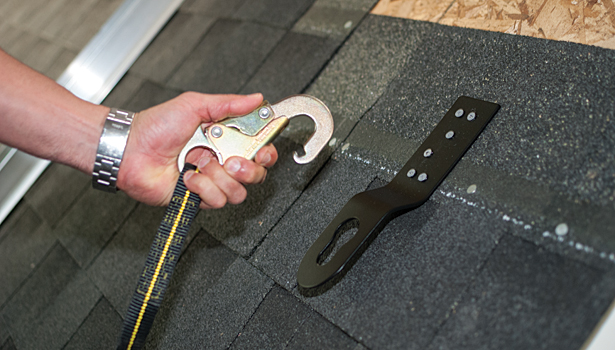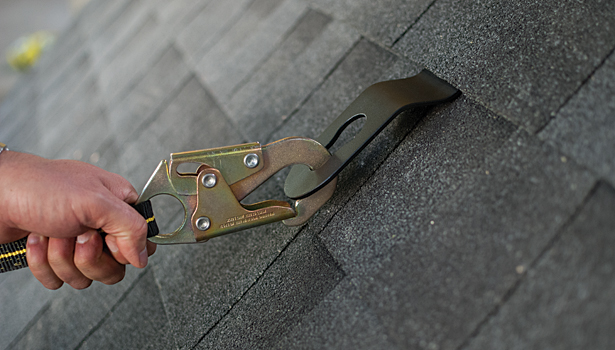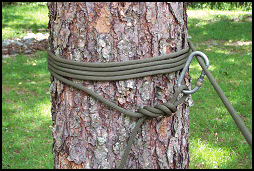Ok I’ve been doing A LOT of homework on this and still have unanswered questions. I have a class 3 harness that I’m getting ready to order but my big concern is a anchor point. Obviously if the property has a solid tree i could use that but what about these homes with zero lot lines and have mostly all shrubs and no natural anchors? I saw the roof vent pipe anchor but considering those vents are made of PVC I don’t feel safe with those. The kind that are nailed to the peak of the roof seem to be the best but I think it’s crazy to put holes into someone’s roof. What is everyone else doing?
Squirting from the ladder.
Wish I could do that all the time. I’m in FL and a lot of homes have pools with screen enclosures. That being said I’d only have 3 clean sides. Wish there was a good ground anchor that could be placed in the ground.
Hitch of your truck. Always lock out tag out though/ keep truck keys in your pocket or hidden so no one decides the truck needs to be moved.
LA Pressure Washing LLC
“Taking Pride In What We Do For You”
Yes I would definitely lock out tag out! But I would still run into an issue with the homes with pools/screen enclosures on the other side of the home. I’d only have fall prevention once I got to the other side of the ridge and nothing from my point of access to the ridge as far as fall protection. Does that make sense the way I explained it?
In Washington, roofs are required to have built in anchor points. Course that doesn’t help with low slope or older homes that are out of compliance. Any reroofing requires the roofer to install anchors as well.
Tony
Pro Long Roof Care
you can use weights, or I have in the past used a picket system… or if you have the ropes make a long run across the roof from end to end tie a prusik around it and tie off to the prusik - just be careful with this as there is a lot more play in the system so if you do end up falling you may go a couple of feet before all the slack is taken up.
I have seen guys use a 3-4 foot pole with a t on the top that they place in the ****ter stack… I guess that would work if it were steel… dont know if I would trust PVC…
Just put in a temporary anchor at the ridge so you can harness around safely.
We have a little roof repair bag with the essentials to make sure we put the roof shingles back properly.
I wish I would have started it much sooner cause we never come across a customer who has legitimate concerns about a few holes that get patched and covered anyway. That fear pales in comparison to a technician falling off their roof. Nobody wants to remembered by their neighbors as the H/O who hired the roof cleaner who was laying dead in the front yard…
It seriously only adds 15 minutes to a job and could save a life. Some accidents can’t be undone
Sent from my iPhone using Pressure Washing Resource
The weight system doesn’t sound bad. I also just heard from a local guy that he uses a water system. Trying to find out exactly what the name of the kit is.
You need to talk to your state agency about what is acceptable and safe. Here is an accident resulting in a death even when the people were harnessed and connected to a portable fall arrestor:
Discussion: The window washer’s “portable support device” also known as the carriage, failed and took the life of one worker (the 15-year-old victim) and seriously injured another.
The FACE investigation review of this incident revealed that the carriage was not properly counterweighted and was not tied into an independent anchor point. Shortly after the incident occurred, during WISHA’s investigation, the counterweights were found on the roof at what appeared to be the previous set-up location where the window washer’s carriage had been. There was no evidence that tie-backs had been used to secure the carriage in either location.
A window washer’s carriage is a piece of mobile equipment that can be set up on the roof of a building that has not been designed with structural devices to assist in external building maintenance, such as window washing. The window washer’s carriage is a metal frame with a beam that supports a boatswain’s chair for the window washer to be lowered down the side of a building. Most are designed with wheels for improved mobility, like the one used in this incident.
There are several basic principles that window washers should follow when working with boatswain’s chairs that use window washer carriages.
First, the carriage must be tied back to an approved anchorage point. The anchorage point should be used exclusively for the carriage. The anchorage point needs to be different from the fall-protection anchorage point for the purpose of safety redundancy. Second, the carriage needs to be counterweighted in order to properly support the window washer, the boatswain’s chair, and assorted equipment while the window washer is working on the building. Counterweight must be properly calculated using a formula that incorporates a minimum safety factor of four (see Figure 5). The counterweights also help with the physical stability of the window washer’s carriage, so that it doesn’t overturn.
The window washer’s carriage should not be moved or relocated while the window washer is still seated in the boatswain’s chair. The window washer needs to be physically out of the chair in a safe location prior to re-positioning the carriage.
Your state can tell you how to set up your equipment safely, I am sure. You pay them, use them!
Tony
Pro Long Roof Care
www.prolongroofcare.com
The issue with wrapping around a tree is that you are attaching to the same safety rope you’re connected too. Your system is only as strong as the weakest point.
We go to our van bumpers, the frame of the van, or the hitch receiver.
If you are going around a tree, buy a chain, wrap the chain around, then connect to the chain.
Make sure the chain is rated high enough!!!
Learn how to install permanent roof anchors and charge for them. They are not rocket science to put on your average asphalt shingle roof. We get $75 each for them and they cost about $16 each in cases of 10. Takes 10 minutes to install. They are value added for the customer and fully OSHA compliant. A tree/chimney/bumper/hitch does not meet OSHA fall safety requirements…but can be used for your initial ascent to the peak to install the anchors as per OSHA.
Metal roofs, if they are standing seam, you can use a standing seam clamp anchor. They are approved.
Tile, I’d stay off of or use a tile anchor.
Cedar, you can use an asphalt anchor, but takes longer to install. Then again, you should be getting 3-4X as much for a cedar roof cleaning anyways.
Well FL isn’t an OSHA state so I’m not too worried about them. I’m just looking for something that can practically protect myself and my employees. As long as it works effectively than I’m happy. 90% of the roofs I clean are tile and never knew they had tile anchors… That good to know! Do you know who sells them? I was just approached by a property manager about doing cedar roofs in a extremely high end residential community. But before I say yes to them I need to educate myself how to clean them. Here we use SH on everything and I don’t want to dry out all the shakes (but that’s a different subject). I’ll definitely use the anchors on those!
OSHA is federal. They are everywhere. https://www.osha.gov/oshdir/fl.html
Tile Anchors…contact the folks at Guardian Safety Products. They make anchors for just about every type of roof there is.
As for Cedar…I am part of Bruce Sullivan’s cedar network. Contact him and tell him you are interested in becoming a member. We modified his system to meet our specific area needs, but that man has cleaned a LOT of cedar…some in Florida as a matter of fact.


This looks easy enough but man, I can’t see trusting that thing in the event of a fall.
I saw that one. I like how it’s low profile but man… I really would hate to peal back someone’s shingles. As far is tile is concern around me… Everything is screwed down. You’d have to rip the roof apart to put one of those in on about 90% of the roofs I clean
@The_Pressure_King I believe you are referring to what’s called a tension less anchor. It’s actually one of the safest, most trustworthy anchors available, as long as the tree you are using can be considered a “bomb-proof” anchor (i.e. Not going anywhere…Not dead, a sapling, weak soil, etc…all pretty easy things to ascertain). The reason it is so strong and reliable is that almost 100% (don’t remember the exact numbers) of your rope strength is retained. The key is to use the largest diameter anchor you can find and wrap your rope around the anchor as many times as possible (at least six wraps) so that even if your knot failed (NOT likely) the friction of the rope on the anchor would still prevent a fall. I’ve gone on telpher systems hundreds of feet above the ground and done pick-offs multiple times in Rescue training on this very anchor and I trust it waaaaay more than I ever would tying to a hitch. Plus, it won’t dig into, and damage, a tree like a chain will. (But a hitch will work if nothing better is available)

(In this picture he should have two more wraps and he is not using a safety knot, but it was the first one I found on Google and it illustrates the system well enough)
That said, I don’t use ropes at all in my business. I spray from the ladder or ground whenever possible and I only walk roofs that are 8/0 pitch or less. If I can’t do the job safely, I pass…there’s way too much easy, safe money to be made in this business.
(Look at a large AODD pump if reach/access are problems.) That’s my next big purchase.
I run (and sell) some of the largest Air Diaphragm pump systems around. But there are many times when due to the shape of a roof, you
just have to get on it.
These are the type of trees I use for anchor points. I’ll usually throw a high strength tow strap around it and use a beaner to attach my safety line. The issue i run into all the time is that there’s only one-two trees like this on each house. These are normally in the front of the house and the back has all smaller trees and a screen enclosure. So I’m secured while cleaning the rear of the house but nothing to tie off to when cleaning the front.

